![]()
| Method no.: | 80 |
| Matrix: | Air |
| Target concentrations: | 500 ppm (1736 mg/m3) OSHA PEL 10 ppm (34.7 mg/m3) |
| Procedure: | Samples are collected by drawing air through glass sampling
tubes containing Carbosieve |
| Recommended air volume and sampling rate: |
3 L at 0.05 L/min |
| Reliable quantitation limit: | 0.201 ppm (0.697 mg/m3) |
| Standard errors of estimate at the target concentration: (Section 4.7.) |
5.8% (10 ppm) 6.5% (500 ppm) |
| Status of method: | Evaluated method. This method has been subjected to the established evaluation procedures of the Organic Methods Evaluation Branch. |
| Date: February 1990 | Chemist: Donald Burright |
OSHA Analytical Laboratory
Salt Lake City, Utah
1. General Discussion
- 1.1. Background
- 1.1.1. History
This procedure allows the use of a single standard size (6-mm
o.d. ×
This evaluation was performed at two target concentrations
because the current OSHA PEL for methylene chloride is 500 ppm
1.1.2. Toxic effects (This section is for information only and should not be taken as the basis of OSHA policy.)
Methylene chloride can affect the body if it is inhaled,
swallowed or comes in contact with the eyes or skin. Methylene
chloride is an anesthetic and inhaling the vapor may cause mental
confusion,
Carbon monoxide is a metabolite of methylene chloride in animals and humans. NIOSH has recommended that if the carbon monoxide concentration is above 9 ppm, either the concentration of methylene chloride or carbon monoxide should be reduced. (Ref. 5.5.)
On the basis of carcinogenic and tumorigenic responses in rats and mice, NIOSH recommends that methylene chloride be regarded as a potential occupational carcinogen. (Ref. 5.3.)
1.1.3. Workplace exposure
Methylene chloride is used mainly as a solvent in paint removers,
aerosol mixtures, chemical reaction processes and as a blowing agent
for flexible foams. Photography,
Approximately 230 million kilograms of methylene chloride were produced in the United States in 1988. (Ref. 5.9.) In 1986, NIOSH estimated that 1 million workers were potentially exposed to methylene chloride. (Ref. 5.5.)
1.1.4. Physical properties and other descriptive information (Ref. 5.10., unless otherwise stated)
| CAS no.: | 75-09-2 |
| molecular weight: | 84.93 |
| molecular formula: | CH2Cl2 |
| melting point: | -97°C |
| boiling point: | 39.8°C |
| vapor pressure: | 53.3 kPa (400 mmHg) at 24.1°C |
| vapor density: | 2.93 (air=1) |
| specific gravity: | 1.3266 (water=1) |
| explosive limit: | 12% (lower) 19% (upper) (Ref. 5.11.) |
| self-ignition temperature: | 640°C (Ref. 5.11.) |
| odor: | penetrating ether-like |
| odor threshold: | 205-307 ppm |
| appearance: | colorless liquid |
| solubility: | 1-2 g/100 mL of water; soluble in most common organic liquids |
| synonyms: | dichloromethane; Aerothene MM; methylene dichloride;
Narkotil; R30; Solaesthin; Solmethine; DCM; methane
dichloride; methylene bichloride; |
The analyte air concentrations throughout this method are based on the recommended sampling and analytical parameters. Air concentrations listed in ppm are referenced to 25°C and 101.3 kPa (760 mmHg).
1.2. Limit defining parameters
- 1.2.1. Detection limit of the analytical procedure
The detection limit of the analytical procedure is 0.0746 ng per
injection
1.2.2. Detection limit of the overall procedure
The detection limit of the overall procedure is 2.09 µg per sample (0.201 ppm or 0.697 mg/m3). This is the amount of analyte spiked on the sampling device that allows recovery of an amount of analyte equivalent to the detection limit of the analytical procedure. (Section 4.2.)
1.2.3. Reliable quantitation limit
The reliable quantitation limit is 2.09 µg per sample (0.201 ppm or 0.697 mg/m3). This is the smallest amount of analyte spiked on the sampling device that can be quantitated within the requirements of a recovery of at least 75% and a precision (±1.96 SD) of ±25% or better. (Section 4.3.)
The reliable quantitation limit and detection limits reported in the method are based upon optimization of the instrument for the smallest possible amount of analyte. When the target concentration of analyte is exceptionally higher than these limits, they may not be attainable at the routine operating parameters.
1.2.4. Instrument response to the analyte
The instrument response over the concentration range of 0.5 to 2
times the
1.2.5. Recovery
The recovery of methylene chloride from samples used in 17-day
storage tests remained above 99.6% and 97.3% at the
1.2.6. Precision (analytical procedure only)
The pooled coefficients of variation obtained from replicate
determinations of analytical standards at 0.5, 1 and 2 times the
target concentrations are 0.0330 and 0.0267 at the
1.2.7. Precision (overall procedure)
The precisions at the 95% confidence level for the 17-day ambient
temperature storage tests are ±11.3% and ±12.7% at the
1.2.8. Reproducibility
Six samples (TC-10) collected from a controlled test atmosphere and a draft copy of this procedure were given to a chemist unassociated with this evaluation. The samples were analyzed after 11 days of refrigerated storage. No individual sample result deviated from its theoretical value by more than the precision reported in Section 1.2.7. (Section 4.8.)
1.3. Advantages
Because methylene chloride does not readily migrate on Carbosieve
S-III, a single standard size Carbosieve
1.4. Disadvantages
- 1.4.1. The fine mesh size of Carbosieve S-III (60/80) results in
a greater pressure drop across the sample tube than occurs with the
conventional coconut shell charcoal sampling tube. This results in
the need for the 0.05 L/min sampling rate.
1.4.2. The recommended sample size is 3 L as opposed to the 10 L sample size of previous methods.
2. Sampling Procedure
- 2.1. Apparatus
- 2.1.1. Samples are collected using a personal sampling pump
calibrated to within ±5% of the recommended flow rate with the
sampling device attached.
2.1.2. Samples are collected with 4-mm i.d. × 6-mm o.d. × 70 mm
glass sampling tubes packed with two sections of 60/80 mesh
Carbosieve
2.2. Reagents
No sampling reagents are required.
2.3. Technique
- 2.3.1. Immediately before sampling, break off the ends of the
Carbosieve
2.3.2. Attach the sampler to the sampling pump with plastic tubing such that the large front section of the sampler is exposed directly to the atmosphere. Do not place any tubing in front of the sampler.
2.3.3. Attach the sampler vertically in the worker's breathing zone in such a manner that it does not impede work performance or safety.
2.3.4. After sampling for the appropriate time, remove the
sampler and seal the tube with plastic end caps. Wrap each sample
2.3.5. Submit at least one blank sampler with each set of samples. Handle the blank sampler in the same manner as the other samples except draw no air through it.
2.3.6. Ship any bulk samples in a container separate from the air samples.
2.4. Sampler capacity
The sampling capacity of the front section of a Carbosieve S-III sampling tube was determined by sampling a test atmosphere containing 20 ppm (69.5 mg/m3, 80% relative humidity) methylene chloride at ambient temperature. The sampling rate was 0.0503 L/min. The 5% breakthrough air volume was 7.6 L. (Section 4.9.)
The 5% breakthrough air volume was 3.34 L when sampling a test atmosphere containing 1018 ppm (3535 mg/m3, 83% relative humidity) of methylene chloride at 0.053 L/min. (Section 4.9.)
2.5. Desorption efficiency
- 2.5.1. The average desorption efficiencies for methylene
chloride from Carbosieve
2.5.2. Desorbed samples remain relativity stable for at least 24 h. (Section 4.10.)
2.6. Recommended air volume and sampling rate
- 2.6.1. For time-weighted average samples collect 3 L at 0.05
L/min.
2.6.2. For ceiling or peak samples (Table Z-2 of Title 29 CFR Part 1910.1000) collect the sample for at least 5 min at 0.05 L/min.
2.6.3. When ceiling or peak samples are required, the reliable quantitation limit becomes larger. For example, the reliable quantitation limit is 2.41 ppm (8.36 mg/m3) for methylene chloride when 0.25 L is collected.
2.7. Interferences (sampling)
- 2.7.1. It is not known if any compounds will severely interfere
with the collection of methylene chloride on Carbosieve
2.7.2. Suspected interferences should be reported to the laboratory with submitted samples.
2.8. Safety precautions (sampling)
- 2.8.1. The sampling equipment should be attached to the worker
in such a manner that it will not interfere with work performance or
safety.
2.8.2. All safety practices that apply to the work area being sampled should be followed.
3. Analytical Procedure
- 3.1. Apparatus
- 3.1.1. A GC equipped with a flame ionization detector (FID). A
3.1.2. A GC column capable of separating methylene chloride from
the desorbing solvent, the internal standard and any potential
interferences. A
3.1.3. An electronic integrator or some other suitable means of
measuring detector response. A
3.1.4. Two-milliliter vials with PTFE-lined caps.
3.1.5. A dispenser capable of delivering 1.0 mL of desorbing
solution is used to prepare standards and samples. If a dispenser is
not available, a
3.2. Reagents
- 3.2.1. Methylene chloride. Reagent grade or better should be
used. The methylene chloride (b&j brand HIGH PURITY SOLVENT)
used in this evaluation was purchased from American Burdick &
Jackson (Muskegon, MI).
3.2.2. Carbon disulfide, CS2. Reagent grade or better CS2 should be used. The CS2 (REAGENT ACS) was purchased from Fisher Scientific (Fair Lawn, NJ). In this evaluation, benzenefree CS2 was used. The CS2 had been passed through Molecular Sieve 13X (45/60 mesh) to remove the benzene contamination. Fifty grams of molecular sieve should remove the benzene from 1 L of carbon disulfide.
3.2.3. Dimethylformamide, DMF. Reagent grade or better should be used. The DMF (b&j brand HIGH PURITY SOLVENT) used in this evaluation was purchased from American Burdick & Jackson (Muskegon, MI).
3.2.4. Sodium sulfate, anhydrous. Sodium sulfate is used as a drying agent. The sodium sulfate (AR grade) used in this evaluation was purchased from Mallinckrodt (Paris, KY).
3.2.5. Desorbing solution. This consists of a solution of 99:1
(v/v)
3.2.6. Ethyl benzene. This was used as the internal standard in the desorbing solution. The solution is prepared by adding 250 µL of ethyl benzene to 1 L of desorbing solution. The ethyl benzene (reagent grade) used in this evaluation was purchased from Eastman Kodak (Rochester, NY).
3.3. Standard preparation
- 3.3.1. Prepare concentrated stock standards by diluting the
methylene chloride with DMF. Prepare working analytical standards by
injecting microliter amounts of concentrated stock standards into
3.3.2. Prepare at least three standards at different concentrations to generate a calibration curve. Ensure that the amount of methylene chloride found in the samples is within the range of the standards. Prepare additional standards if necessary.
3.4. Sample preparation
- 3.4.1. Remove the plastic caps from the sample tube and
carefully transfer each section of the adsorbent to separate vials.
Discard the glass tube and glass wool plugs.
3.4.2. Add approximately 150 mg of anhydrous sodium sulfate to each sample.
3.4.3. Add 1.0 mL of desorbing solution to each vial and
immediately seal the vials with
3.4.4. Shake the vials vigorously by hand several times during the next 30 min.
3.5. Analysis
- 3.5.1. Analytical conditions
| GC conditions | |
| temperatures: | 40°C (column) 200°C (injector) 220°C (detector) |
| temp program: | hold initial temp 1.0 min, increase temp at 5°C/min to 65°C, then increase temp at 25°C/min to 190°C. |
| column gas flow: | 1.20 mL/min (hydrogen) |
| septum purge: | 1.5 mL/min (hydrogen) |
| injection size: | 1.0 µL (with an appropriate split) |
| column: | 30 m × 0.32-mm i.d. capillary SUPELCOWAX 10 (0.25 µm film thickness) column |
| retention times: | 4.3 min (methylene chloride) 7.2 min (ethyl benzene) |
| FID conditions | |
| hydrogen flow: | 34 mL/min |
| air flow: | 450 mL/min |
| nitrogen makeup flow: | 33 mL/min |
| chromatogram: | Figure 3.5.1. |
3.5.2. Measure detector response using a suitable method such as electronic integration.
3.5.3. An internal standard (ISTD) calibration method is used. A
calibration curve can be constructed by plotting micrograms of
methylene chloride per sample versus
3.6. Interferences (analytical)
- 3.6.1. Any compound that responds on an FID and has a similar
retention time as the analyte or internal standard is a potential
interference. Generally, chromatographic conditions can be altered
to separate an interference from the analyte.
3.6.2. Retention time on a single column is not considered proof of chemical identity. Analysis by an alternate GC column or confirmation by mass spectrometry are additional means of identification.
3.7. Calculations
The analyte concentration for samples is obtained from the
appropriate calibration curve in terms of micrograms per sample,
uncorrected for desorption efficiency. The air concentration is
calculated using the following formulae. The back
| mg/m3 = | (micrograms of analyte per sample)
(liters of air sampled)(desorption efficiency) |
where desorption efficiency = 1.05 for TC-10 or 0.989 for TC-500
| ppm = | (mg/m3)(24.46)
(molecular weight of analyte) |
where 24.46 = molar volume (liters) at 101.3 pKa (760
mmHg) and 25°C
molecular
weight = 84.93
3.8. Safety precautions (analytical)
- 3.8.1. Restrict the use of all chemicals to a fume hood if
possible.
3.8.2. Avoid skin contact and inhalation of all chemicals.
3.8.3. Wear safety glasses and a lab coat at all times while in the laboratory areas.
4. Backup Data
- 4.1. Detection limit of the analytical procedure
The detection limit of the analytical procedure is 0.0746 ng per
injection, based on a
4.2. Detection limit of the overall procedure
The detection limit of the overall procedure is 2.09 µg per sample
(0.201 ppm or 0.697 mg/m3). The injection
size listed in the analytical procedure (1.0 µL) was used in the
determination of the detection limit of the overall procedure. Eight
vials containing 130 mg of Carbosieve
|
| ||
| sample no. | µg spiked | µg recovered |
|
| ||
| 1 2 3 4 5 6 7 8 |
2.09 2.09 2.09 2.09 2.09 2.09 2.09 2.09 |
2.40 2.28 2.29 2.31 2.33 2.31 2.25 2.13 |
|
| ||
4.3. Reliable quantitation limit data
The reliable quantitation limit is 2.09 µg per sample (0.201 ppm or
0.697 mg/m3). The injection size listed in
the analytical procedure (1.0 µL) was used in the determination of the
reliable quantitation limit. Eight vials containing 130 mg of
Carbosieve
|
| ||
| percent recovered |
statistics | |
|
| ||
| 114.8 109.1 109.6 110.5 111.5 110.5 107.7 101.9 |
SD = Precision = = |
109.5 3.7 (1.96)(±3.7) ±7.3 |
|
| ||
4.4. Instrument response to methylene chloride
The instrument response to methylene chloride over the range of 0.5
to 2 times the
|
| |||
| × TC-10 µg/mL ppm/sample |
0.5× 52.1 5.00 |
1× 104.2 10.00 |
2× 208.4 20.01 |
|
| |||
| area counts | 261 278 277 276 276 266 264 272 |
550 520 581 532 542 539 535 530 |
1073 1105 1055 1063 1033 1030 1159 1074 |
| 271.3 | 541.1 | 1074.0 | |
|
| |||
|
| |||
| × TC-10 mg/mL ppm/sample |
0.5× 2.65 254.5 |
1× 5.30 509 |
2× 10.6 1018 |
|
| |||
| area counts | 3935 4005 3977 3944 4191 4188 4116 4070 |
8105 7750 7685 7801 8191 8151 8119 8190 |
15786 15637 15354 15846 15392 16088 15395 16638 |
| 4053.3 | 7999.0 | 15767.0 | |
|
| |||
- 4.5.1. Storage test at 10 ppm
Thirty-six storage samples were collected by sampling a
dynamically generated atmosphere containing 57.4
mg/m3 or 16.5 ppm of methylene chloride
and 80% relative humidity for 30 min at 0.05 L/min.
|
| |||||||
| storage time (days) |
% recovery (ambient) |
% recovery (refrigerated) | |||||
|
| |||||||
| 0 4 7 11 14 17 |
101.1 99.4 98.5 101.2 106.3 104.9 109.4 |
101.1 100.1 98.4 99.6 103.9 96.9 99.1 |
98.9 100.0 99.5 99.5 101.2 101.2 98.7 |
101.1 99.4 100.8 100.6 98.7 102.3 94.9 |
101.1 100.1 103.3 94.8 108.6 100.4 95.1 |
98.9 100.0 95.9 99.6 102.4 97.7 104.9 | |
|
| |||||||
4.5.2. Storage test at 500 ppm
Thirty-six storage samples were collected by sampling a
dynamically generated atmosphere containing 3516
mg/m3 or 1013 ppm of methylene chloride
and 86% relative humidity for 30 min at 0.05 L/min.
|
| |||||||
| storage time (days) |
% recovery (ambient) |
% recovery (refrigerated) | |||||
|
| |||||||
| 0 3 6 11 14 17 |
99.8 96.8 94.7 93.6 93.4 102.9 100.3 |
98.3 97.9 103.6 96.3 92.3 94.0 102.7 |
104.4 102.9 90.4 97.4 94.7 96.5 98.9 |
99.8 96.8 95.7 99.6 89.3 87.5 94.3 |
98.3 97.9 96.0 92.2 97.2 95.5 92.9 |
104.4 102.9 97.9 89.4 94.1 87.8 100.3 | |
|
| |||||||
4.6. Precision (analytical method)
The precision of the analytical procedure is defined as the pooled
coefficient of variation determined from replicate injections of
methylene chloride standards at 0.5, 1 and 2 times the
![]() ) were calculated and are listed below.
) were calculated and are listed below.
|
| |||
| × TC-10 µg/mL ppm/sample |
0.5× 52.1 5.00 |
1× 104.2 10.00 |
2× 208.4 20.01 |
|
| |||
| SD1 CV |
6.64 0.02451 |
18.38 0.03397 |
41.89 0.03901 |
|
1 standard deviation is in area counts | |||
|
| |||
| × TC-10 mg/mL ppm/sample |
0.5× 2.65 254.5 |
1× 5.30 509 |
2× 10.6 1018 |
|
| |||
| SD1 CV |
103.8 0.02561 |
214.4 0.02681 |
436.7 0.02770 |
|
1 standard deviation is in area counts | |||
4.7. Precision (overall procedure)
The precision of the overall procedure is determined from the storage data. The determination of the standard error of estimate (SEE) for a regression line plotted through the graphed storage data allows the inclusion of storage time as one of the factors affecting overall precision. The SEE is similar to the standard deviation except it is a measure of dispersion of data about a regression line instead of about a mean. It is determined with the following equation:

| where | n = k = k = |
total no. of data points 2 for linear regression 3 for quadratic regression |
| Yobs = | observed % recovery at a given time | |
| Yest = | estimated % recovery from the regression line at the same given time |
An additional 5% for pump error is added to the SEE by the addition
of variances. The precision at the 95% confidence level is obtained by
multiplying the SEE (with pump error included) by 1.96 (the
Six samples, collected from a dynamically generated atmosphere
containing methylene chloride, were given to a chemist unassociated
with this study. The samples were generated by drawing the
|
| |||
| µg spiked | µg recovered | % recovered | % deviation |
|
| |||
| 147.7 149.8 102.6 100.2 172.7 172.0 |
145.6 148.8 94.4 97.1 162.3 154.2 |
98.6 99.3 92.0 96.9 94.0 89.6 |
-1.4 -0.7 -8.0 -3.1 -6.0 -10.4 |
|
| |||
- 4.9.1. Breakthrough for TC-10
Sampler capacity was determined by sampling from a dynamically
generated atmosphere of 20 ppm (69.5
mg/m3) methylene chloride with a
Carbosieve
|
| |||
| air vol (L) |
amt found (µg) |
downstream mg/m3 |
breakthrough (%) |
|
| |||
| 0.75 2.26 3.77 4.91 5.66 6.41 7.17 7.92 8.68 9.43 10.2 10.9 11.7 |
2.56 0 0 0 0 2.39 0 2.50 4.32 6.99 8.49 12.6 14.5 |
1.696 0 0 0 0 3.162 0 3.308 5.720 9.244 11.26 16.61 19.25 |
2.44 0 0 0 0 4.55 0 4.76 8.23 13.3 16.2 23.9 27.7 |
|
| |||
4.9.2. Breakthrough for TC-500
Sampler capacity was determined by sampling from a dynamically
generated atmosphere of 1018 ppm (3535
mg/m3, 83% relative humidity) methylene
chloride with a Carbosieve
4.10. Desorption efficiency and stability of desorbed samples
- 4.10.1. Desorption efficiency
The desorption efficiency (DE) of methylene chloride was
determined by
|
| |||
| × TC-10 µg/sample |
0.5× 52.1 |
1× 104.2 |
2× 208.4 |
|
| |||
| DE, % | 101.9 106.7 108.6 100.5 97.1 104.6 105.9 108.7 |
103.0 112.9 103.2 108.9 106.2 99.7 101.0 108.0 |
108.4 105.4 109.6 106.5 105.0 106.2 107.7 102.9 |
| 104.3 | 105.4 | 106.4 | |
|
| |||
|
| |||
| × TC-10 mg/sample |
0.5× 2.65 |
1× 5.31 |
2× 10.6 |
|
| |||
| DE, % | 101.2 98.9 100.9 100.6 99.3 96.8 102.9 95.6 |
103.2 101.5 98.4 99.2 98.8 94.9 98.2 104.6 |
99.6 96.7 95.4 93.6 99.7 97.7 99.1 95.5 |
| 99.5 | 99.9 | 97.2 | |
|
| |||
4.10.2. Stability of desorbed samples
The stability of desorbed samples was investigated by reanalyzing
the
|
| ||
| initial recovery (percent) |
recovery after 24 h (percent) |
percent change |
|
| ||
| 93.9 105.1 94.7 86.8 91.4 93.7 |
102.0 101.1 97.6 102.6 98.4 100.7 |
+8.1 -4.0 +2.9 +15.8 +7.0 +7.0 |
|
| ||
The stability of desorbed samples was investigated by reanalyzing
the
|
| ||
| initial recovery (percent) |
recovery after 24 h (percent) |
percent change |
|
| ||
| 95.8 100.8 97.9 99.0 98.5 98.9 |
103.6 100.3 101.5 102.4 94.8 104.4 |
+7.8 -0.5 +3.6 +3.4 -3.7 +5.5 |
|
| ||
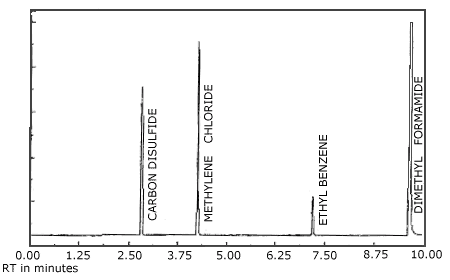
Figure 3.5.1. Chromatogram of methylene chloride at the TC-10 target concentration.
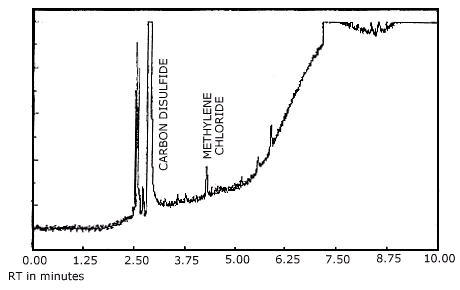
Figure 4.1. Chromatogram of methylene chloride at the detection limit, 0.0746 ng per injection, injection split = 28:1.
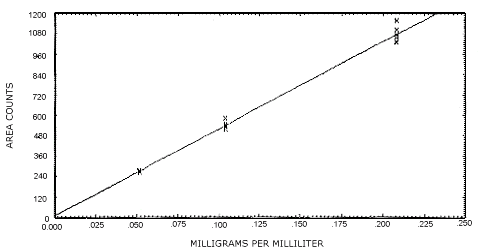
Figure 4.4.1. Instrument response curve for methylene chloride at 10 ppm, slope = 322 area counts per micrograms per milliliter, injection split = 8:1.
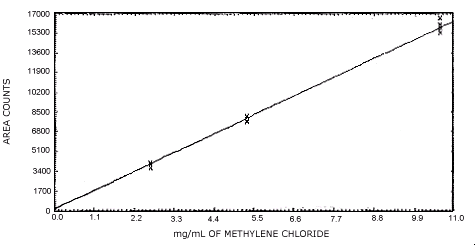
Figure 4.4.2. Instrument response curve for methylene chloride at 500 ppm, slopes = 1474 area counts per micrograms per milliliter, injection split = 28:1.
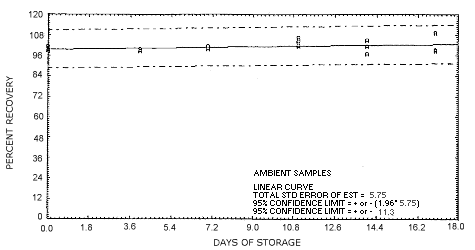
Figure 4.5.1.1. Ambient storage test for methylene chloride at 10 ppm.
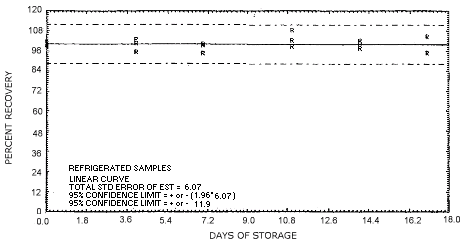
Figure 4.5.1.2. Refrigerated storage test for methylene chloride at 10 ppm.
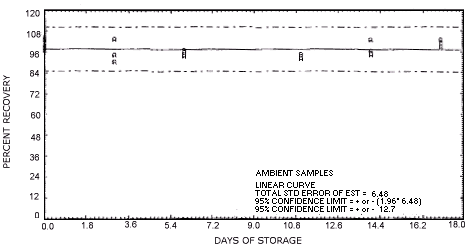
Figure 4.5.2.1. Ambient storage test for methylene chloride at 500 ppm.
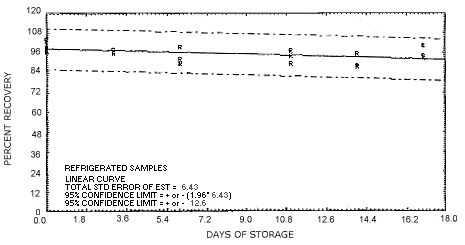
Figure 4.5.2.2. Refrigerated storage test for methylene chloride at 500 ppm.
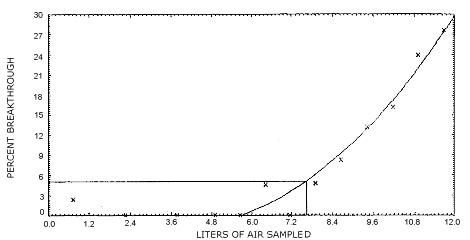
Figure 4.9.1. Determination of the 5% breakthrough air volume at 10 ppm.
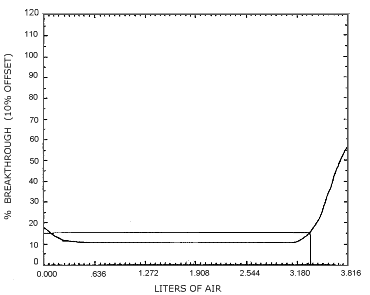
Figure 4.9.2. Determination of the 5% breakthrough air volume at 500 ppm.
5. References
- 5.1. "NIOSH Manual of Analytical Methods", 3rd
ed.; U.S. Department of Health and Human Services, Center for Disease
Control, NIOSH; Cincinnati, OH, 1984, Method 1005, DHHS (NIOSH) Publ.
No.
5.2. Cummins, K.J. "OSHA Method No. 59; Methylene Chloride", OSHA Analytical Laboratory, unpublished, Salt Lake City, UT 84165, April, 1986.
5.3. "Air Contaminants - Permissible Exposure Limits", Code of Federal Regulations, Title 29; 1910.1000, U.S. Department of Labor, OSHA; Washington, D.C., 1989, DOL (OSHA) Publ. No. OSHA 3112.
5.4. "American Conference of Government
Industrial Hygienists: Threshold Limit Values and Biological Indices
for
5.5. "Current Intelligent Bulletin 46, Methylene Chloride"; April 18, 1986, U.S Department of Health and Human Services, Public Health Service, Center for Disease Control, NIOSH.
5.6. "Occupational Health Guidelines for Methylene Chloride", U.S Department of Health and Human Services, Center for Disease Control, NIOSH, September 1978.
5.7. International Agency for Research on Cancer,
"IARC Monographs on the Evaluation of the Carcinogenic Risk of
Chemicals to Humans: Some Halogenated Hydrocarbons and Pesticide
Exposures", IARC, Lyon, Switzerland, 1986, Vol. 41, pp.
5.8. Anthony, T. in "Kirk-Othmer Encyclopedia of
Chemical Technology"; 3rd ed.; Grayson, M., Ed.; John Wiley &
Sons, New York, 1983, Vol. 5, pp.
5.9. Chemical and Engineering News, Vol. 67, No. 25, Jun 19, 1989, p. 41.
5.10. ChemInfo Database on CCINFO CD-ROM disc 89-2, Canadian Centre for Occupational Health and Safety, Hamilton, Ontario.
5.11. CAMEO Database, National Oceanic and Atmospheric Administration Hazardous Materials Response Branch, Seattle, WA.